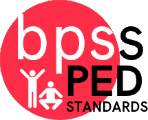BPS Physical Education Standards Book
Completion requirements
Standards
Fitness Concepts
-
- PED-00.S5.01: Recognizes that physical activity is important for good health.
- PED-00.S5.02: Acknowledges that some physical activities are challenging/difficult.
- PED-00.S5.03b: Discusses the enjoyment of playing with friends.
- PED-00.S5.03a: Identifies physical activities that are enjoyable.
-
- PED-01.S5.01: Identifies physical activity as a component of good health.
- PED-01.S5.02: Recognizes that challenge in physical activities can lead to improvement.
- PED-01.S5.03a: Describes positive feelings that result from participating in physical activities.
- PED-01.S5.03b: Discusses personal reasons for enjoying physical activities (the why).
-
- PED-02.S5.01: Recognizes the relationship between physical activity and good health.
- PED-02.S5.02: Compares physical activities that bring confidence and challenge
- PED-02.S5.03: Identifies physical activities that provide self-expression (e.g., rhythmic activities/dance, gymnastics routines, practice tasks in game environments).
-
- PED-03.S5.01: Discusses the relationship between physical activity and good health.
- PED-03.S5.02: Discusses the challenge that comes from learning a new physical activity.
- PED-03.S5.03: Reflects on the reasons for enjoying selected physical activities.
- PED-03.S5.04: Describes the positive social interactions that come when engaged with others in physical activity.
-
- PED-04.S5.01: Examines the health benefits of participating in physical activity.
- PED-04.S5.02: Rates the enjoyment of participating in challenging and mastered physical activities.
- PED-04.S5.03: Ranks the enjoyment of participating in different physical activities. (
- PED-04.S5.04: Describes and compares the positive social interactions when engaged in partner, small-group and large-group physical activities.
-
- PED-05.S5.01: Compares the health benefits of participating in selected physical activities.
- PED-05.S5.02: Expresses (e.g., written essay, visual art, creative rhythmic activities/dance) the enjoyment and/or challenge of participating in a favorite physical activity. (
- PED-05.S5.03: Analyzes different physical activities for enjoyment and challenge, identifying reasons for a positive or negative response.
- PED-05.S5.04: Describes the social benefits gained from participating in physical activity (e.g., recess, youth sport).
- (H) Cluster Health
- PED-06.S5.H.01: Describes how being physically active leads to a healthy body.
- PED-06.S5.H.02: Identifies components of physical activity that provide opportunities for reducing stress and other Social interaction.
- (CH) Cluster Challenge
- PED-06.S5.CH.01: Recognizes individual challenges and copes in a positive way, such as extending effort, asking for help/feedback and/or modifying the tasks.
- (SE) Cluster Self expression and enjoyment
- PED-06.S5.SE.01: Describes how moving competently in a physical activity setting creates enjoyment.
- PED-06.S5.SE.02: Identifies how self-expression and physical activity are related.
- (SI) Cluster Social Interaction
- PED-06.S5.SI.01: Demonstrates respect for self and others in activities and games by following the rules, encouraging others and playing within the spirit of the game or activity.
- (H) Cluster: Health
- PED-07.S5.H.01: Identifies different types of physical activities and describes how each exerts a positive impact on health.
- PED-07.S5.H.02: Identifies positive mental and emotional aspects of participating in a variety of physical activities.
- (CH) Cluster: Challenge
- PED-07.S5.CH.01: Generates positive strategies such as offering suggestions/assistance, leading/following others and/or providing possible solutions when faced with a group challenge.
- (SE) Cluster: Self expression and enjoyment
- PED-07.S5.SE.01: Identifies why self-selected physical activities create enjoyment.
- PED-07.S5.SE.02: Explains the relationship between self-expression and lifelong enjoyment through physical activity.
- (SI) Cluster: Social Interaction
- PED-07.S5.SI.01: Demonstrates the importance of Social interaction by helping and encouraging others, avoiding trash talk and providing support to classmates.
- (H) Cluster: Health
- PED-08.S5.H.01: Identifies and explains the connection between the five components of health-related fitness (muscle strength, muscle endurance, ?exibility, cardiovascular endurance and body composition) and overall physical and mental health.
- PED-08.S5.H.02: Analyzes the empowering benefits of being physical active.
- (CH) Cluster: Challenge
- PED-08.S5.CH.01: Develops a plan of action and makes appropriate decisions based on that plan when faced with an individual challenge.
- (SE) Cluster: Self-expression and enjoyment
- PED-08.S5.SE.01: Discusses how enjoyment could be increased in self-selected physical activities.
- PED-08.S5.SE.02: Identi?es and participates in an enjoyable activity that prompts individual self-expression.
- (SI) Cluster: Social Interaction
- PED-08.S5.SI.01: Demonstrates respect for sell by asking for help and helping others in various physical activities.
- (H) Cluster: Health
- PED-HS.S5.H.01: Analyzes the health benefits of a self-selected physical activity and proper nutrition.
- (CH) Cluster: Challenge
- PED-HS.S5.CH.02: Chooses an appropriate level of challenge to experience success and desire to participate in a self-selected physical activity.
- (SE) Cluster: Self-expression and enjoyment
- PED-HS.S5.SE.03: Selects and participates in physical activities or rhythmic activities/dance that meet the need for self-expression and enjoyment.
- (SI) Cluster: Social Interactions
- PED-HS.S5.SI.04: Identifies the opportunity for social support in a self-selected physical activity or rhythmic activities/dance.

